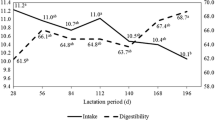Summary
Two experiments with 12 and 18 lactating Jersey cows respectively were carried out in the coastal semi-humid zone of Kenya to assess the performance arising from the feeding of chopped Napier fodder(Pennisetum purpureum) givenad libitum with and without one of three sources of protein; fishmeal, copra cake and freshly cut Leucaena(Leucaena leucocephala). Each source supplied approximately 300 g crude protein daily. Dry matter intakes of Napier fodder fed alone averaged 7·1 and 5·5 kg in Experiments 1 and 2 respectively. Additional protein did not affect Napier fodder intake, but total intakes of dry matter were higher for the cows receiving the protein supplements, differences which were significant(P<0·05) in Experiment 2. Average daily milk production from cows fed Napier fodder alone was 6·4 and 4·2 kg in Experiments 1 and 2 respectively. The additional 300 g crude protein increased milk production by 1·0 to 1·6 kg/day, increases which, except that for fishmeal, were significant(P<0·05). Weight losses of the cows were either reduced or changed to weight gains by the provision of protein. The results are assessed in relation to the energy and protein requirements for milk production.
Résumé
Deux expériences, comportant respectivement 12 et 18 vaches Jersiaises en lactation, ont été conduites en zone côtière semi-humide du Kenya afin d'étudier les performances résultant d'une alimentation au fourrage haché dePennisetum purpureum donnéad libitum. Les rations étaient accompagnées ou non de trois sources de protéines: farine de poisson, tourteau de coprah etLeucaena leucocephala fraîchement coupée. Chaque source apportait approximativement 300 q de protéines brutes par jour. La quantité de fourrage d'herbe de napier consommée seule atteignait en moyenne 7,1 et 5,5 kg, respectivement, dans les expériences 1 et 2. Le complément protéinique ne modifiait pas la prise de fourrage dePennisetum purpureum, mais les consommations globales, exprimés en matière sèche, étaient plus élevées pour les vaches en bénéficiant. Les différences étaine significatives pourP<0,05 dans l'expérience 2. La production moyenne journalière de lait des vaches nourries exclusivement au fourrage deP. purpureum était de 6,4 et 4,2 kg dans les expériences 1 et 2, respectivement. Les 300 q de complément protéinique brut augmentaient la production quotidienne de lait de 1,0 à 1,6 kg, chiffres significatifs (P<0,05) à l'exception de la farine de poisson. Les pertes pondérales de vaches étaient soient réduites soit inversées en gain de poids par la distribution de protéines. Ces résultats sont évaluées par rapport aux besoins énergétiques et en protéines requis pour la production laitière.
Resumen
Se Ilevaron a cabo dos experimentos con 12 y 18 vacas Jersey en lactación, respectivamente, en la zona costera semi-húmeda de Kenia, para estudiar la producción de leche resultado de la alimentación con pasto napier picado (Pennisetum purpureum) ad libitum, con o sin una de tres fuentes protecias: harina de pescado, torta de copra yLeucaena leucocephala cortada fresca. Cada fuente, suplió aproximadamente 300 g de proteína cruda diariamente. El consumo de materia seca (MS) de pasto napier solo promedió 7·1 y 5·5 kg en el experimento 1 y 2, respectivamente. La proteína adicional no afectó el consumo de napier, pero el consumo total de MS fue más alto en las vacas con suplemento proteico, diferencias que fueron significativas (P<0·05) en el experimento 2. La producción promedia de leche de las vacas que consumieron napier solo, fue de 6·4 y 4· 2 kg en experimentos 1 y 2 respectivamente. Los 300 g de proteína cruda incrementaron la producción de 1·0 a 1·6 kg/día, incrementos que, excepto en el case de la harina de pescado, fueron significativos (P<0·05). Las pérdidas de peso de las vacas se redujeron, o aumentaron de peso con el suplemento proteico. Los resultados se avalan en relación con los requerimientos energéticos y proteicos para la producción de leche.
Similar content being viewed by others
References
Agricultural Research Council (1980).The Nutrient Requirements of Ruminant Livestock. Commonwealth Agricultural Bureaux, Farnham Royal, Slough.
Agricultural Research Council (1984).The Nutrient Requirements of Ruminant Livestock. Supplement No. 1. Commonwealth Agricultural Bureaux, Farnham Royal, Slough.
Alexander, R.H. &McGowan, M. (1966).Journal of the British Grassland Society,21, 140–147.
Anindo, D. O. &Potter, H. L. (1986).East African Agriculture and Forestry Journal,52, 106–111.
A.O.A.C. (1980).Official Methods of Analysis of the Association of Official Analytical Chemists. 13th Edition. (Ed. W. Horwitz) Washington, D.C., USA.
Arias, P. J. &Combellas, J. (1979). Informe Anual del Instituto de Produccion Animal. Facultad de Agronomia, Universidad Central de Venezuela, Maracay.
Hardison, W. A. (1966). Chemical composition, nutrient intake and potential milk producing capacity of fresh tropical herbage. Dairy Training and Research Institute, U.P. College of Agriculture, Laguna, Philippines. Technical Bulletin No. 1.
Jaetzold, R. &Schmidt, H. (1983).Farm Managemetn of Kenya. Vol. 11 C. National Conditions and Farm Management Information. East Kenya. A description of the Kenyan Coast. pp. 332–333.
Maloo, S. H. (1988) Annual Report. Veterinary Investigation Laboratory, Mariakani. Ministry of Livestock Development Kenya. pp. 7.
Mureithi, J. G. (1990). Research on Feed Resource Development Working Document No. 1 June 1990 KARI/ILCA: Collaborative Research on Smallholder Dairy Production in the Coast Subhumid Zone. International Livestock Centre for Africa, Mombasa, Kenya. 30 pp.
Orskov, E. R. &McDonald, I. (1979).Journal of Agricultural Science, Cambridge,92, 499–503.
SAS, Statistical Analysis Systems Institute (1987)Guide for Personal Computers, version 6 edition. SAS Insitute Inc. Cary, North Carolina, USA. pp. 551–640.
Wouters, A. P. (1987).Dry matter yield and quality of Napier grass on Farm Level 1983–1986. National Dairy Development Programme Report, Naivasha, Kenya. pp 24–29.
Author information
Authors and Affiliations
Rights and permissions
About this article
Cite this article
Muinga, R.W., Thorpe, W. & Topps, J.H. Lactational performance of jersey cows given Napier fodder (Pennisetum purpureum) with and without protein concentrates in the semi-humid tropics. Trop Anim Health Prod 25, 118–128 (1993). https://doi.org/10.1007/BF02236519
Accepted:
Issue Date:
DOI: https://doi.org/10.1007/BF02236519




